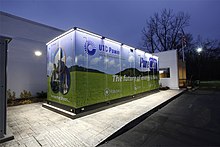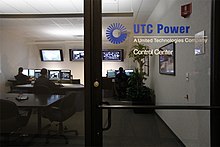
A fuel cell is an electrochemical cell that converts the chemical energy of a fuel and an oxidizing agent into electricity through a pair of redox reactions. Fuel cells are different from most batteries in requiring a continuous source of fuel and oxygen to sustain the chemical reaction, whereas in a battery the chemical energy usually comes from substances that are already present in the battery. Fuel cells can produce electricity continuously for as long as fuel and oxygen are supplied.
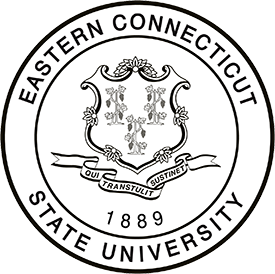
Eastern Connecticut State University is a public university in Willimantic, Connecticut. Founded in 1889, it is the second-oldest campus in the Connecticut State University System and third-oldest public university in the state. Eastern is located on Windham Street in Willimantic, Connecticut, on 182 acres (0.74 km2) 30 minutes from Hartford, lying midway between New York City and Boston. Although the majority of courses are held on the main campus, select classes take place at Manchester Community College, Capital Community College, and a satellite center in Groton.
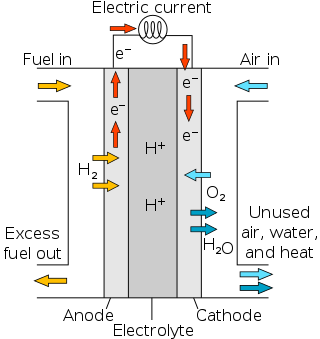
Phosphoric acid fuel cells (PAFC) are a type of fuel cell that uses liquid phosphoric acid as an electrolyte. They were the first fuel cells to be commercialized. Developed in the mid-1960s and field-tested since the 1970s, they have improved significantly in stability, performance, and cost. Such characteristics have made the PAFC a good candidate for early stationary applications.

A fuel cell vehicle (FCV) or fuel cell electric vehicle (FCEV) is an electric vehicle that uses a fuel cell, sometimes in combination with a small battery or supercapacitor, to power its onboard electric motor. Fuel cells in vehicles generate electricity generally using oxygen from the air and compressed hydrogen. Most fuel cell vehicles are classified as zero-emissions vehicles. As compared with internal combustion vehicles, hydrogen vehicles centralize pollutants at the site of the hydrogen production, where hydrogen is typically derived from reformed natural gas. Transporting and storing hydrogen may also create pollutants. Fuel cells have been used in various kinds of vehicles including forklifts, especially in indoor applications where their clean emissions are important to air quality, and in space applications. Fuel cells are being developed and tested in trucks, buses, boats, ships, motorcycles and bicycles, among other kinds of vehicles.
The MTA Regional Bus Operations bus fleet is a fleet of buses in fixed-route service in New York City under the "MTA New York City Bus" and "MTA Bus" brands, both of which operate local, limited, express and Select Bus Service routes.

The California Fuel Cell Partnership (CaFCP) is a public-private partnership to promote hydrogen vehicles (including cars and buses) in California. It is notable as one of the first initiatives for that purpose undertaken in the United States. The challenge is which come first, hydrogen cars or filling stations.

South Windsor High School is located in South Windsor, Connecticut. It currently serves grades 9-12 with approximately 1,364 students and a 13:1 student-teacher ratio. It is the only high school in South Windsor, but also admits students from Hartford through the Open Choice Program. The school offers a variety of courses spanning departments such as mathematics, science, social studies, language arts, foreign languages, music, art, and technology. The school also offers over 80 options for extracurricular activities and 30 options for afterschool athletics.

CT Transit is a public transportation bus system serving many metropolitan areas and their surrounding suburbs in the state of Connecticut. CT Transit is a division of the Connecticut Department of Transportation, although it contracts a number of private companies for most of its operations. CT Transit began operations in 1976 as Connecticut Transit after the Connecticut DOT's acquisition of the Connecticut Company. Initially serving only the Hartford, New Haven, and Stamford areas, CT Transit's service now extends throughout much of Connecticut. CT Transit provides local "city bus" service in Bristol, Hartford, Meriden, New Britain, New Haven, Stamford, Wallingford and Waterbury in addition to a number of express routes connecting to outlying suburbs and other regions of the state.

The Connecticut Department of Transportation is responsible for the development and operation of highways, railroads, mass transit systems, ports and waterways in Connecticut.

A fuel cell bus is a bus that uses a hydrogen fuel cell as its power source for electrically driven wheels, sometimes augmented in a hybrid fashion with batteries or a supercapacitor. The only emission from the bus is water. Several cities around the world have trialled and tested fuel cell buses, with over 5,600 buses in use worldwide, the majority of which are in China.

Saint Francis Hospital & Medical Center is a 617-bed acute care hospital located on Woodland Street in Hartford, Connecticut. The hospital was established in 1897 by the Sisters of Saint Joseph of Chambéry. With 617 beds and 65 bassinets, it is the largest Catholic hospital in New England.
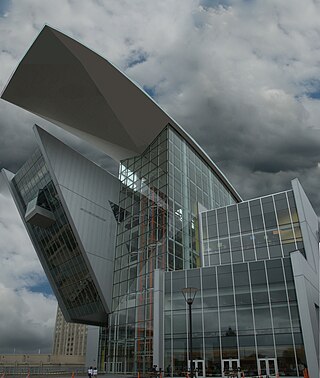
The Connecticut Science Center is a nine-story museum located on the Connecticut River in Hartford, Connecticut designed by César Pelli & Associates, which opened on June 12, 2009. The building measures a total of 154,000 square feet (14,300 m2), including 40,000 square feet (3,700 m2) of interactive exhibits consisting of videos, audios, visuals, tactile components, programs, and live demonstrations.

Proterra Inc. was an American electric vehicle and powertrain manufacturer based in Burlingame, California. The company designed and manufactured battery electric transit buses, powertrain systems for other heavy-duty vehicle builders and charging systems for fleets of heavy-duty vehicles.

ClearEdge Power, Inc. was a fuel cell manufacturer focusing on the stationary fuel cell. It was headquartered in South Windsor, Connecticut, U.S. The company employed 225 people as of August 2011. It closed its operations in Connecticut in April 2014, and filed for Chapter 11 bankruptcy protection in May 2014. The company's assets were purchased out of bankruptcy by Doosan Fuel Cell America, Inc.

The principle of a fuel cell was discovered by Christian Friedrich Schönbein in 1838, and the first fuel cell was constructed by Sir William Robert Grove in 1839. The fuel cells made at this time were most similar to today's phosphoric acid fuel cells. Most hydrogen fuel cells today are of the proton exchange membrane (PEM) type. A PEM converts the chemical energy released during the electrochemical reaction of hydrogen and oxygen into electrical energy. The Hydrogen Research, Development, and Demonstration Act of 1990 and Energy Policy Act of 1992 were the first national legislative articles that called for large-scale hydrogen demonstration, development, and research programs. A five-year program was conducted that investigated the production of hydrogen from renewable energy sources and the feasibility of existing natural gas pipelines to carry hydrogen. It also called for the research into hydrogen storage systems for electric vehicles and the development of fuel cells suitable to power an electric motor vehicle.

The PureCell System is a stationary phosphoric acid fuel cell designed, manufactured and marketed by Doosan Fuel Cell America of South Windsor, Connecticut. Designed for distributed generation and micro combined heat and power applications, it is intended for industrial buildings such as hotels, hospitals, data centers, supermarkets, and educational institutions. PureCell System says that its users will see lower energy costs, reduced emissions, 95% system efficiency, 10-year cell stack durability and 20-year product life.

FuelCell Energy, Inc. is a publicly traded fuel cell company, headquartered in Danbury, Connecticut. It designs, manufactures, operates and services Direct Fuel Cell power plants.

The New Flyer Xcelsior is a line of transit buses available in 35-foot rigid, 40-foot rigid, and 60-foot articulated nominal lengths manufactured by New Flyer Industries since 2008. In addition to the different available lengths, the buses are sold with a variety of propulsion systems: conventional diesel, compressed natural gas (CNG), diesel-electric hybrid, hydrogen fuel cell, overhead electric wire and battery electric. A future autonomous bus variant was announced in January 2021.
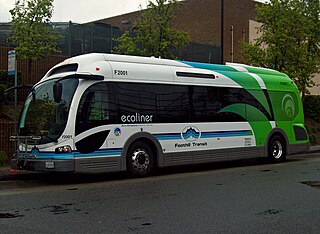
The Proterra EcoRide BE35 is a 35 foot (11 m) fast-charge battery electric bus that seats 38 with a total passenger capacity of 60 in its composite low floor body. Foothill Transit was the first transit agency to operate the buses in revenue service, starting in September 2010. It is the first 30 ft (9 m) or larger, heavy-duty all-electric bus ever to complete federally required durability, reliability and safety testing at the Bus Research and Testing Center in Altoona, Pennsylvania. The 12yr/500,000 mi (800,000 km) STURAA test was completed on March 5, 2012.

The ENC Axess is a line of low-floor transit buses available in 35-foot and 40-foot nominal lengths manufactured by ENC in Riverside, California starting from 2003. In addition to the different available lengths, the buses are sold with a variety of prime movers, ranging from conventional diesel, LNG/CNG combustion engines, diesel-electric hybrid and hydrogen fuel cell with a traction motor.
